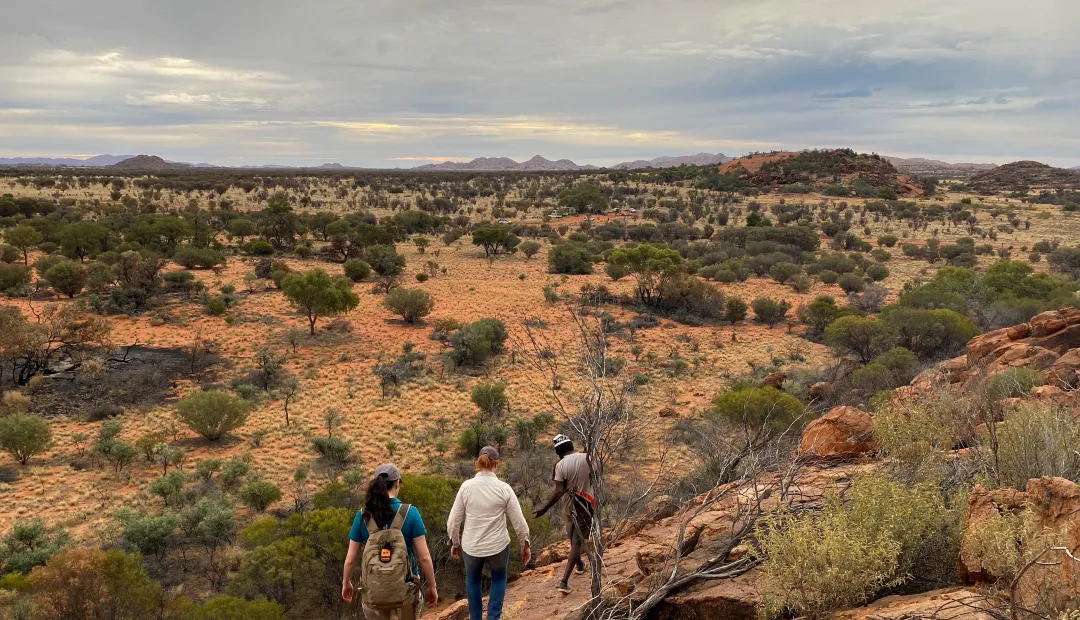Published:
Author:
The Alinytjara Wilurara Landscape Board (AWLB) has proudly supported the Anangu Pitjantjatjara Yankunytjatjara Lands’ (APY) Warru Recovery Project since 2007. Listed as Endangered in South Australia, and Vulnerable under national legislation, the Black-flanked Rock-wallaby (warru) was an abundant species in central Australia. Reports from the 1930s refer to 'one of the commonest animals with swarming populations'. However, barely 30 years later they were considered rare in South Australia and by 2007 the population had dropped to the brink of extinction.
The plight of the warru, as a culturally important species, was brought to the fore by a group of senior Anangu women who were a strong force behind the drive to revive warru numbers and have them reinstated at locations they previously inhabited. Since then, two Warru Ranger teams have been established and with ongoing training are supporting the Warru Recovery Project.
The Warru Recovery Project is an Anangu-led project, protecting a priority listed threatened species in a remote area, using traditional ecological knowledge alongside the latest available technology and scientific understanding.
Over the past 15 years, with the support of AWLB and other key partners, significant progress has been made in increasing warru numbers and establishing new populations at various locations across the APY Lands.
Warru raised in captivity were initially released into a predator-free fenced area known as the Pintji. Over the years, multiple translocations have been conducted: warru taken from the Pintji and established wild populations then reintroduced to former habitats. The first of these reintroductions took place at Wamitjara, where the translocated population continues to grow.
In August 2022, AWLB's translocation and population management of Warru (Black-footed Rock-wallaby) into former habitats within the APY lands, South Australia project reintroduced 40 warru into the Everard Ranges near Kulitjara, where they had been locally extinct for 60 years. The translocation was successful, with a warru population established and 80% surviving, and the warru breeding 12 months post reintroduction. A second translocation took place in October 2023, adding 45 adult warru to the Kulitjara population.
AWLB’s support includes funding, field staff (including an ecologist), training for Anangu rangers, mapping, and data management services.
Work done in support of warru as part of this project includes feral predator monitoring and control, buffel grass management, fire management, threatened species monitoring, and ranger exchanges with Aboriginal ranger groups from other regions. Buffel grass expansion represents a key threat to all warru populations and has not been slowed despite considerable effort.
"Anangu rangers really value their work and their role in the Warru Recovery Project. Being a Ranger is important work,” says Grant Nyaningu, a long-term Warru Ranger, who helped build the Pintji.
"The old people told us to get around the land and look after the land. Now the old people are happy because the warru population’s growing. Old people love to see young people working on lands and protecting their own lands and looking after Country.”
Warru are culturally important animals for Anangu and preserving the species is vital for ecological and cultural reasons. Community support for the warru translocations at Wamitjara and Kulitjara is strong, with many community members proud to be involved in the protection of the warru population. The Minyma (Anangu senior women) had worked for many years to see warru returned to the Everard Ranges and their emotional response to seeing warru back at Kulitjara for the first time in many years was a great positive outcome of the project.
More than 50 Anangu were involved in planning and consultation in 2020–21 alone, and 34 rangers participated in on-ground activities in 2022.
Since 2007, the population trajectory of the species has significantly improved, but this improvement is from a very low base and much more needs to be done to secure the future of warru in the APY Lands.
The Warru Recovery Team comprised Anangu Warru Rangers, APY Land Management staff, staff from the Alinytjara Wilurara Landscape Board and the Department of Environment and Water, Zoos SA and independent scientists.
Past funding for AWLB’s involvement has been primarily provided through the Australian Government’s National Landcare Program.








